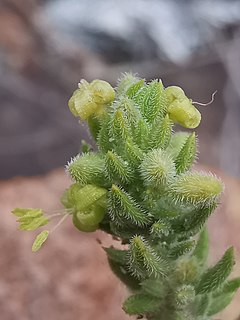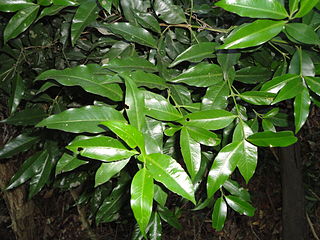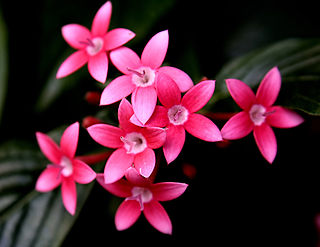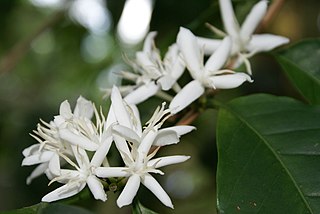
Anthospermum is a genus of flowering plants in the family Rubiaceae. It is found in Tropical and Southern Africa, Madagascar and in southwestern Arabian Peninsula.

Bertiera is a genus of flowering plants in the family Rubiaceae. It comprises 57 species with most known from tropical Africa, five known from various Indian Ocean islands and five found in the tropics of the Americas.
Calycosiphonia is a genus of flowering plants in the family Rubiaceae. It is native to tropical Africa from Ivory Coast to Sudan to Mozambique.
Multidentia is a genus of flowering plants in the family Rubiaceae.

Pavetta is a genus of flowering plants in the family Rubiaceae. It comprises about 360 species of trees, evergreen shrubs and sub-shrubs. It is found in woodlands, grasslands and thickets in sub-tropical and tropical Africa and Asia. The plants are cultivated for their simple but variable leaves, usually opposite but also occur in triple whorls. The leaves are often membranous with dark bacterial nodules. Pavetta has small, white, tubular flowers, sometimes salviform or funnel-shaped with 4 spreading petal lobes. The flowers are carried on terminal corymbs or cymes.

Polysphaeria is a genus of plant in the family Rubiaceae, and its native range is Madagascar and Tropical Africa. It contains the following 22 species according to Plants of the World Online:

Rothmannia is a genus of flowering plants in the family Rubiaceae. It was described in 1776 and is named for Göran Rothman (1739–1778) by Thunberg – both were pupils of Linnaeus.
Rytigynia is a genus of flowering plants in the family Rubiaceae. It is found in tropical and southern Africa. The genera Rytigynia and Fadogia form a strongly supported clade but neither of these genera is monophyletic.
Sericanthe is a genus of flowering plants in the family Rubiaceae. It is found in tropical and subtropical Africa. The genus was described by Elmar Robbrecht in 1978 based on the species in Neorosea, except for the type species, Neorosea jasminiflora, which went to Tricalysia. Bacterial leaf nodules are found in most of the species and the endophytic bacteria have been identified as Burkholderia.

Tricalysia is a genus of flowering plants in the family Rubiaceae. The genus is found in tropical and southern Africa and on the islands in the Western Indian Ocean.

Vangueria is a genus of flowering plants in the family Rubiaceae. The genus is named for Voa vanguer, as V. madagascariensis is known in Malagasy.

Fadogia is a genus of flowering plants in the family Rubiaceae. The genera Rytigynia and Fadogia form a strongly supported clade but neither of these genera is monophyletic.
Vangueriella is a genus of flowering plants in the family Rubiaceae. The genus is found in tropical Africa.
Cuviera is a genus of flowering plants in the family Rubiaceae native to tropical Africa. It was originally described by Augustin Pyramus de Candolle in 1807 and is named after the French naturalist Georges Cuvier.
Virectaria is a genus of flowering plants in the family Rubiaceae. The genus, known as Virecta until 1952, consists exclusively of tropical African species. It is a Guineo-Congolian genus, having its highest diversity in Lower Guinea but it also occurs in the Zambezian Region. Verdcourt provided a revision in which he defined five species but three more were added later. In 2001, a detailed morphological and anatomical study of the genus was conducted and a taxonomic survey and a key to the species was provided.

Empogona is a genus of flowering plants in the family Rubiaceae. The genus is found in tropical and southern Africa and Madagascar. It was for a time deemed a subgenus or section of Tricalysia.
Chazaliella is a genus of flowering plants in the family Rubiaceae. It has about 20 species native to tropical Africa from Liberia to Tanzania and south to Zimbabwe.

Knoxieae is a tribe of flowering plants in the family Rubiaceae and contains about 131 species in 16 genera. Its representatives are found in Tropical and Southern Africa, the islands in the Western Indian Ocean, the Arabian Peninsula, Tropical and Subtropical Asia, and Northern Australia.

Coffeeae is a tribe of flowering plants in the family Rubiaceae and contains about 333 species in 11 genera. Its representatives are found in tropical and southern Africa, Madagascar, the western Indian Ocean, tropical and subtropical Asia, and Queensland.










